REM500 Assignment: Financial Feasibility and Market Analysis Report
VerifiedAdded on 2022/08/26
|12
|2290
|9
Report
AI Summary
This report presents a comprehensive financial feasibility and market analysis for a hostel development project near the University of Toronto, addressing the growing demand for student accommodation. The analysis begins with key assumptions regarding loan financing, vacancy rates, and expens...

Running head: REAL ESTATE MANAGEMENT
1
Real Estate Management
Name:
Institution:
Date:
1
Real Estate Management
Name:
Institution:
Date:
Paraphrase This Document
Need a fresh take? Get an instant paraphrase of this document with our AI Paraphraser
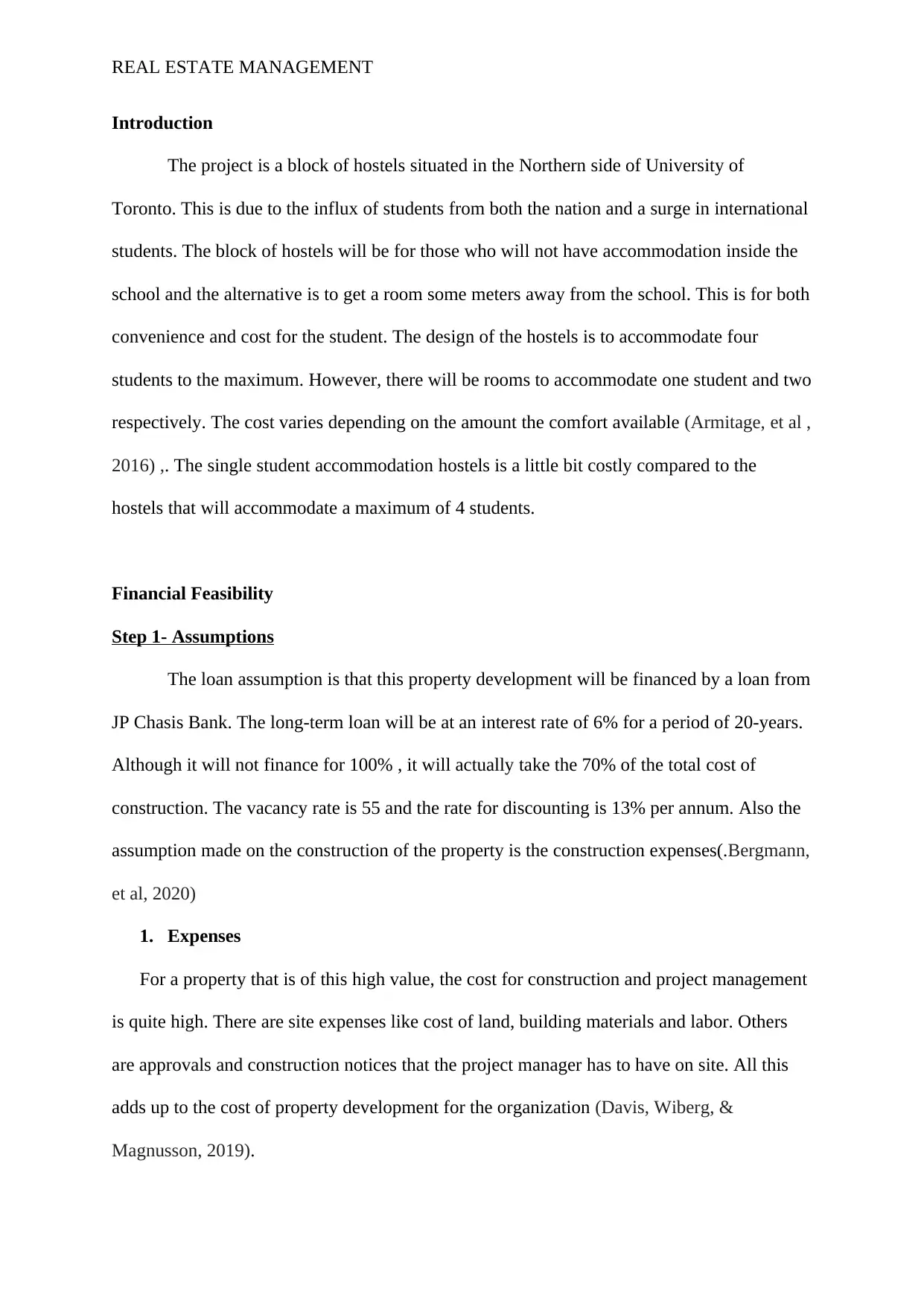
REAL ESTATE MANAGEMENT
Introduction
The project is a block of hostels situated in the Northern side of University of
Toronto. This is due to the influx of students from both the nation and a surge in international
students. The block of hostels will be for those who will not have accommodation inside the
school and the alternative is to get a room some meters away from the school. This is for both
convenience and cost for the student. The design of the hostels is to accommodate four
students to the maximum. However, there will be rooms to accommodate one student and two
respectively. The cost varies depending on the amount the comfort available (Armitage, et al ,
2016) ,. The single student accommodation hostels is a little bit costly compared to the
hostels that will accommodate a maximum of 4 students.
Financial Feasibility
Step 1- Assumptions
The loan assumption is that this property development will be financed by a loan from
JP Chasis Bank. The long-term loan will be at an interest rate of 6% for a period of 20-years.
Although it will not finance for 100% , it will actually take the 70% of the total cost of
construction. The vacancy rate is 55 and the rate for discounting is 13% per annum. Also the
assumption made on the construction of the property is the construction expenses(.Bergmann,
et al, 2020)
1. Expenses
For a property that is of this high value, the cost for construction and project management
is quite high. There are site expenses like cost of land, building materials and labor. Others
are approvals and construction notices that the project manager has to have on site. All this
adds up to the cost of property development for the organization (Davis, Wiberg, &
Magnusson, 2019).
Introduction
The project is a block of hostels situated in the Northern side of University of
Toronto. This is due to the influx of students from both the nation and a surge in international
students. The block of hostels will be for those who will not have accommodation inside the
school and the alternative is to get a room some meters away from the school. This is for both
convenience and cost for the student. The design of the hostels is to accommodate four
students to the maximum. However, there will be rooms to accommodate one student and two
respectively. The cost varies depending on the amount the comfort available (Armitage, et al ,
2016) ,. The single student accommodation hostels is a little bit costly compared to the
hostels that will accommodate a maximum of 4 students.
Financial Feasibility
Step 1- Assumptions
The loan assumption is that this property development will be financed by a loan from
JP Chasis Bank. The long-term loan will be at an interest rate of 6% for a period of 20-years.
Although it will not finance for 100% , it will actually take the 70% of the total cost of
construction. The vacancy rate is 55 and the rate for discounting is 13% per annum. Also the
assumption made on the construction of the property is the construction expenses(.Bergmann,
et al, 2020)
1. Expenses
For a property that is of this high value, the cost for construction and project management
is quite high. There are site expenses like cost of land, building materials and labor. Others
are approvals and construction notices that the project manager has to have on site. All this
adds up to the cost of property development for the organization (Davis, Wiberg, &
Magnusson, 2019).
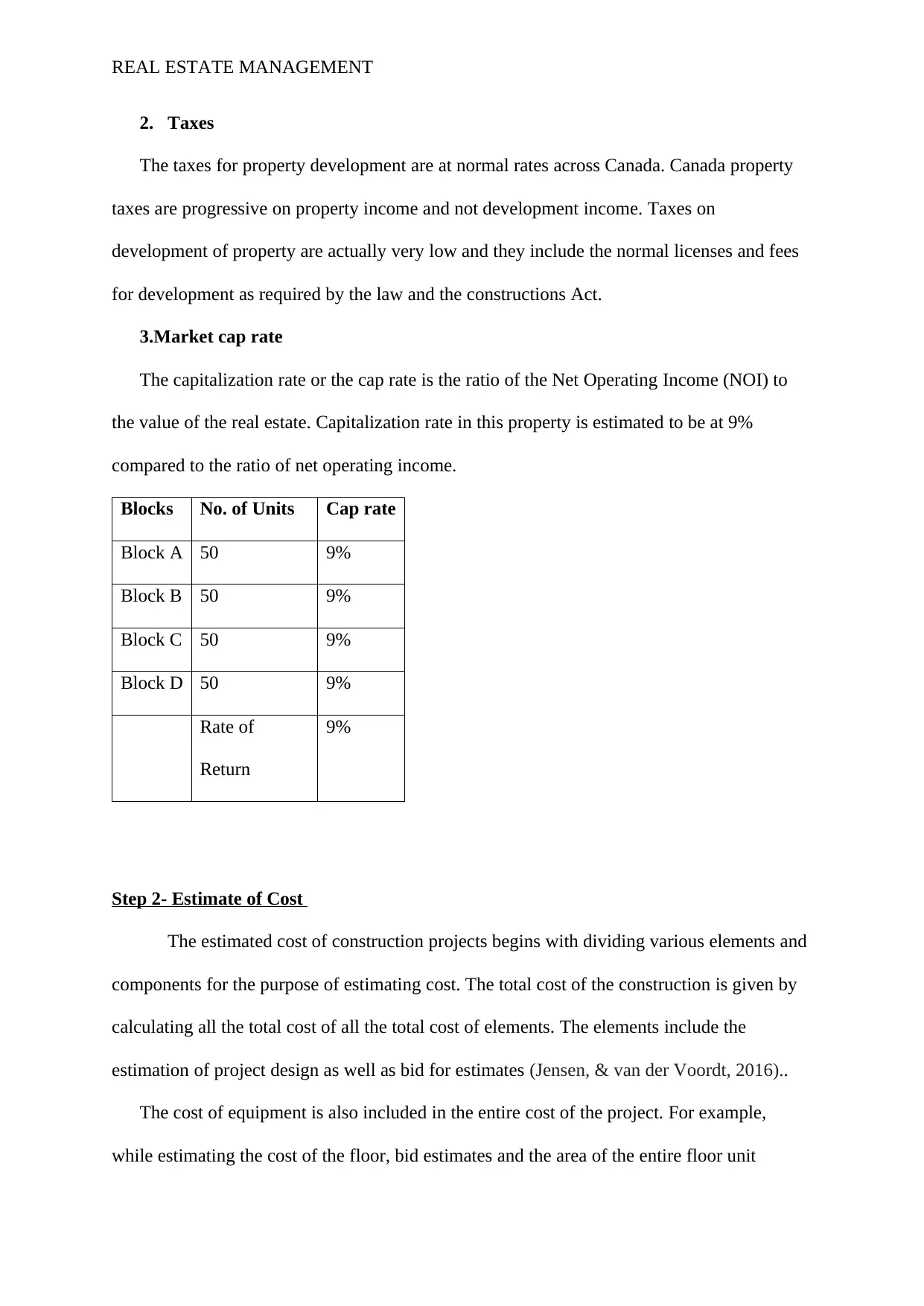
REAL ESTATE MANAGEMENT
2. Taxes
The taxes for property development are at normal rates across Canada. Canada property
taxes are progressive on property income and not development income. Taxes on
development of property are actually very low and they include the normal licenses and fees
for development as required by the law and the constructions Act.
3.Market cap rate
The capitalization rate or the cap rate is the ratio of the Net Operating Income (NOI) to
the value of the real estate. Capitalization rate in this property is estimated to be at 9%
compared to the ratio of net operating income.
Blocks No. of Units Cap rate
Block A 50 9%
Block B 50 9%
Block C 50 9%
Block D 50 9%
Rate of
Return
9%
Step 2- Estimate of Cost
The estimated cost of construction projects begins with dividing various elements and
components for the purpose of estimating cost. The total cost of the construction is given by
calculating all the total cost of all the total cost of elements. The elements include the
estimation of project design as well as bid for estimates (Jensen, & van der Voordt, 2016)..
The cost of equipment is also included in the entire cost of the project. For example,
while estimating the cost of the floor, bid estimates and the area of the entire floor unit
2. Taxes
The taxes for property development are at normal rates across Canada. Canada property
taxes are progressive on property income and not development income. Taxes on
development of property are actually very low and they include the normal licenses and fees
for development as required by the law and the constructions Act.
3.Market cap rate
The capitalization rate or the cap rate is the ratio of the Net Operating Income (NOI) to
the value of the real estate. Capitalization rate in this property is estimated to be at 9%
compared to the ratio of net operating income.
Blocks No. of Units Cap rate
Block A 50 9%
Block B 50 9%
Block C 50 9%
Block D 50 9%
Rate of
Return
9%
Step 2- Estimate of Cost
The estimated cost of construction projects begins with dividing various elements and
components for the purpose of estimating cost. The total cost of the construction is given by
calculating all the total cost of all the total cost of elements. The elements include the
estimation of project design as well as bid for estimates (Jensen, & van der Voordt, 2016)..
The cost of equipment is also included in the entire cost of the project. For example,
while estimating the cost of the floor, bid estimates and the area of the entire floor unit
⊘ This is a preview!⊘
Do you want full access?
Subscribe today to unlock all pages.

Trusted by 1+ million students worldwide
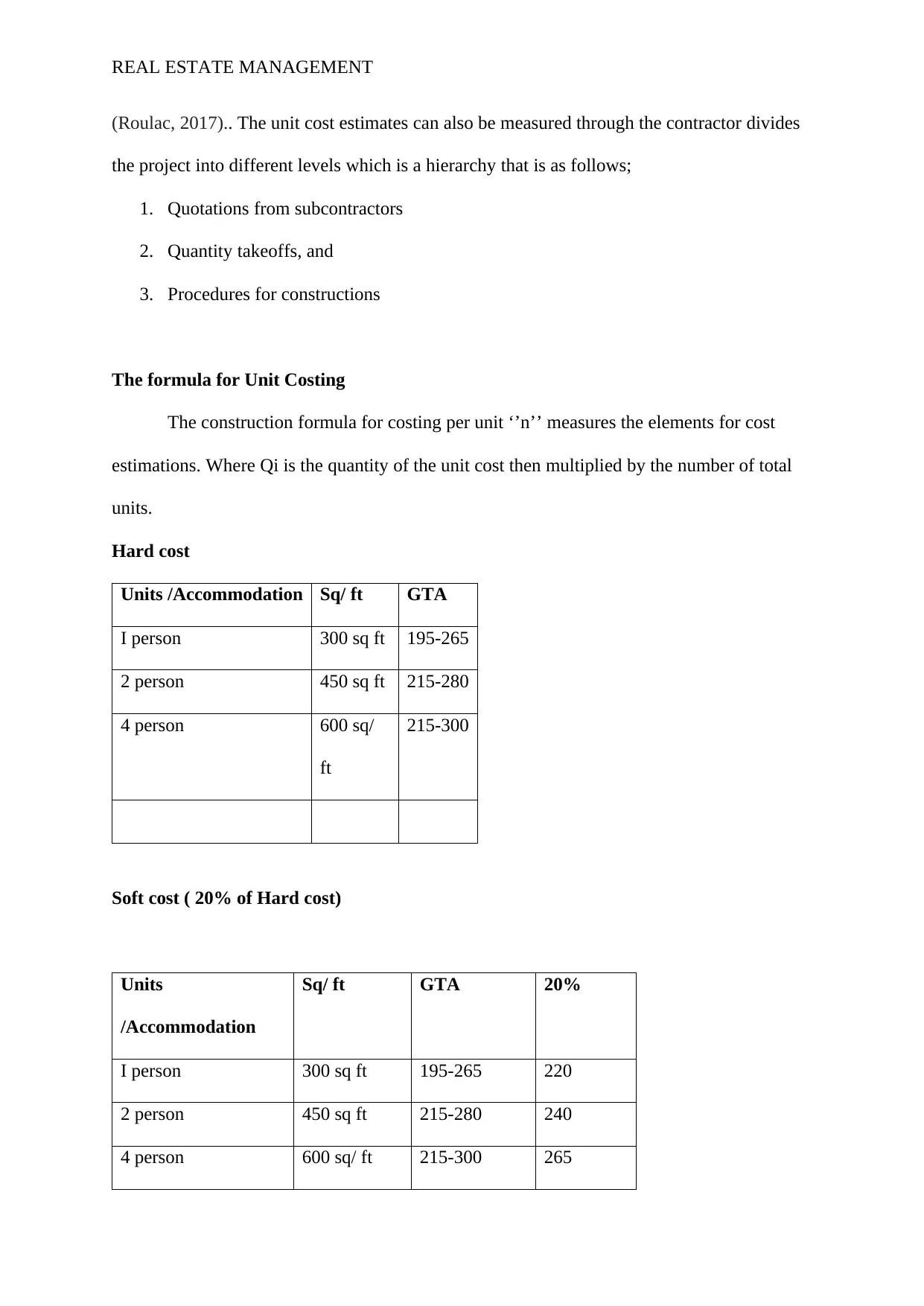
REAL ESTATE MANAGEMENT
(Roulac, 2017).. The unit cost estimates can also be measured through the contractor divides
the project into different levels which is a hierarchy that is as follows;
1. Quotations from subcontractors
2. Quantity takeoffs, and
3. Procedures for constructions
The formula for Unit Costing
The construction formula for costing per unit ‘’n’’ measures the elements for cost
estimations. Where Qi is the quantity of the unit cost then multiplied by the number of total
units.
Hard cost
Units /Accommodation Sq/ ft GTA
I person 300 sq ft 195-265
2 person 450 sq ft 215-280
4 person 600 sq/
ft
215-300
Soft cost ( 20% of Hard cost)
Units
/Accommodation
Sq/ ft GTA 20%
I person 300 sq ft 195-265 220
2 person 450 sq ft 215-280 240
4 person 600 sq/ ft 215-300 265
(Roulac, 2017).. The unit cost estimates can also be measured through the contractor divides
the project into different levels which is a hierarchy that is as follows;
1. Quotations from subcontractors
2. Quantity takeoffs, and
3. Procedures for constructions
The formula for Unit Costing
The construction formula for costing per unit ‘’n’’ measures the elements for cost
estimations. Where Qi is the quantity of the unit cost then multiplied by the number of total
units.
Hard cost
Units /Accommodation Sq/ ft GTA
I person 300 sq ft 195-265
2 person 450 sq ft 215-280
4 person 600 sq/
ft
215-300
Soft cost ( 20% of Hard cost)
Units
/Accommodation
Sq/ ft GTA 20%
I person 300 sq ft 195-265 220
2 person 450 sq ft 215-280 240
4 person 600 sq/ ft 215-300 265
Paraphrase This Document
Need a fresh take? Get an instant paraphrase of this document with our AI Paraphraser
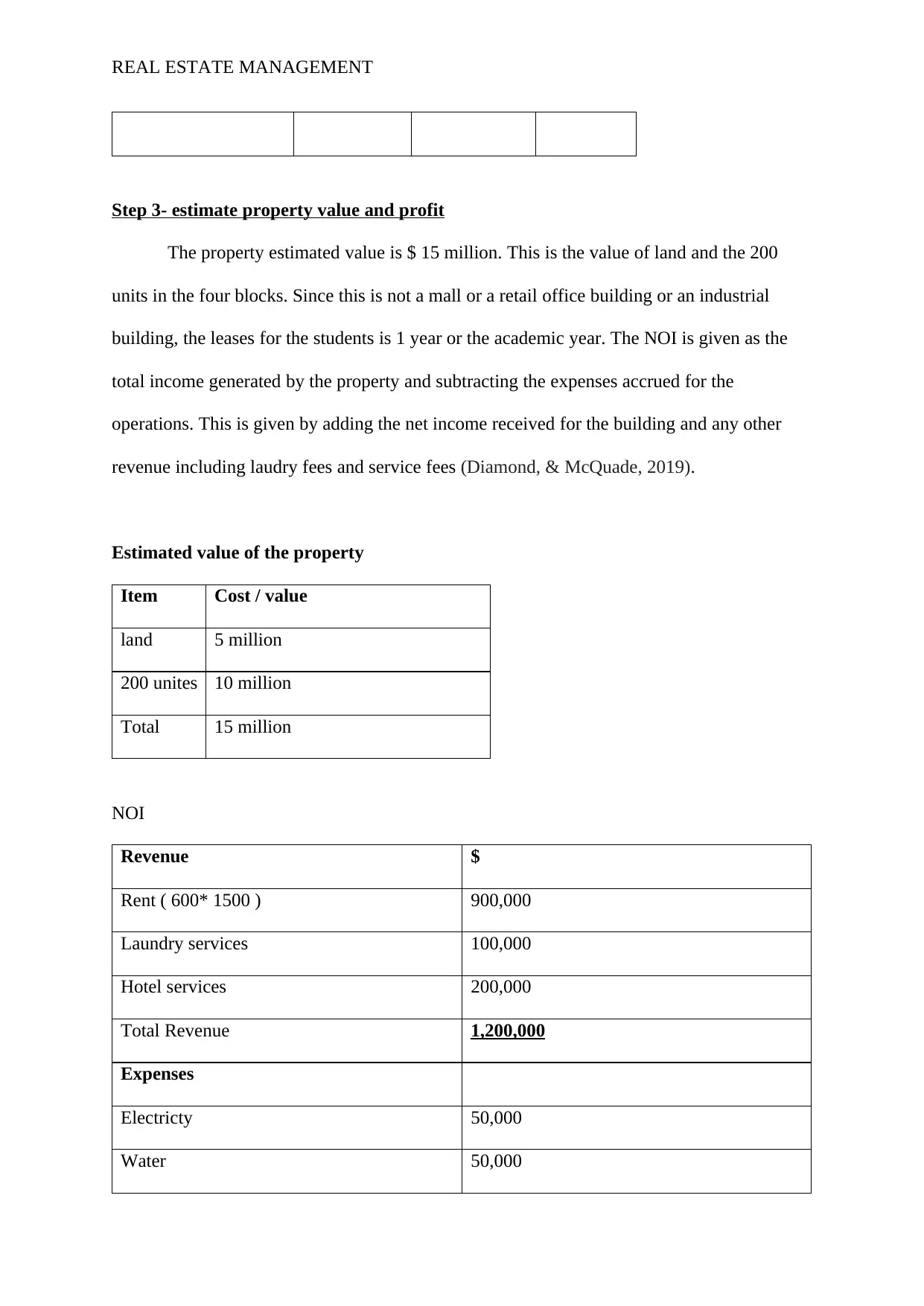
REAL ESTATE MANAGEMENT
Step 3- estimate property value and profit
The property estimated value is $ 15 million. This is the value of land and the 200
units in the four blocks. Since this is not a mall or a retail office building or an industrial
building, the leases for the students is 1 year or the academic year. The NOI is given as the
total income generated by the property and subtracting the expenses accrued for the
operations. This is given by adding the net income received for the building and any other
revenue including laudry fees and service fees (Diamond, & McQuade, 2019).
Estimated value of the property
Item Cost / value
land 5 million
200 unites 10 million
Total 15 million
NOI
Revenue $
Rent ( 600* 1500 ) 900,000
Laundry services 100,000
Hotel services 200,000
Total Revenue 1,200,000
Expenses
Electricty 50,000
Water 50,000
Step 3- estimate property value and profit
The property estimated value is $ 15 million. This is the value of land and the 200
units in the four blocks. Since this is not a mall or a retail office building or an industrial
building, the leases for the students is 1 year or the academic year. The NOI is given as the
total income generated by the property and subtracting the expenses accrued for the
operations. This is given by adding the net income received for the building and any other
revenue including laudry fees and service fees (Diamond, & McQuade, 2019).
Estimated value of the property
Item Cost / value
land 5 million
200 unites 10 million
Total 15 million
NOI
Revenue $
Rent ( 600* 1500 ) 900,000
Laundry services 100,000
Hotel services 200,000
Total Revenue 1,200,000
Expenses
Electricty 50,000
Water 50,000
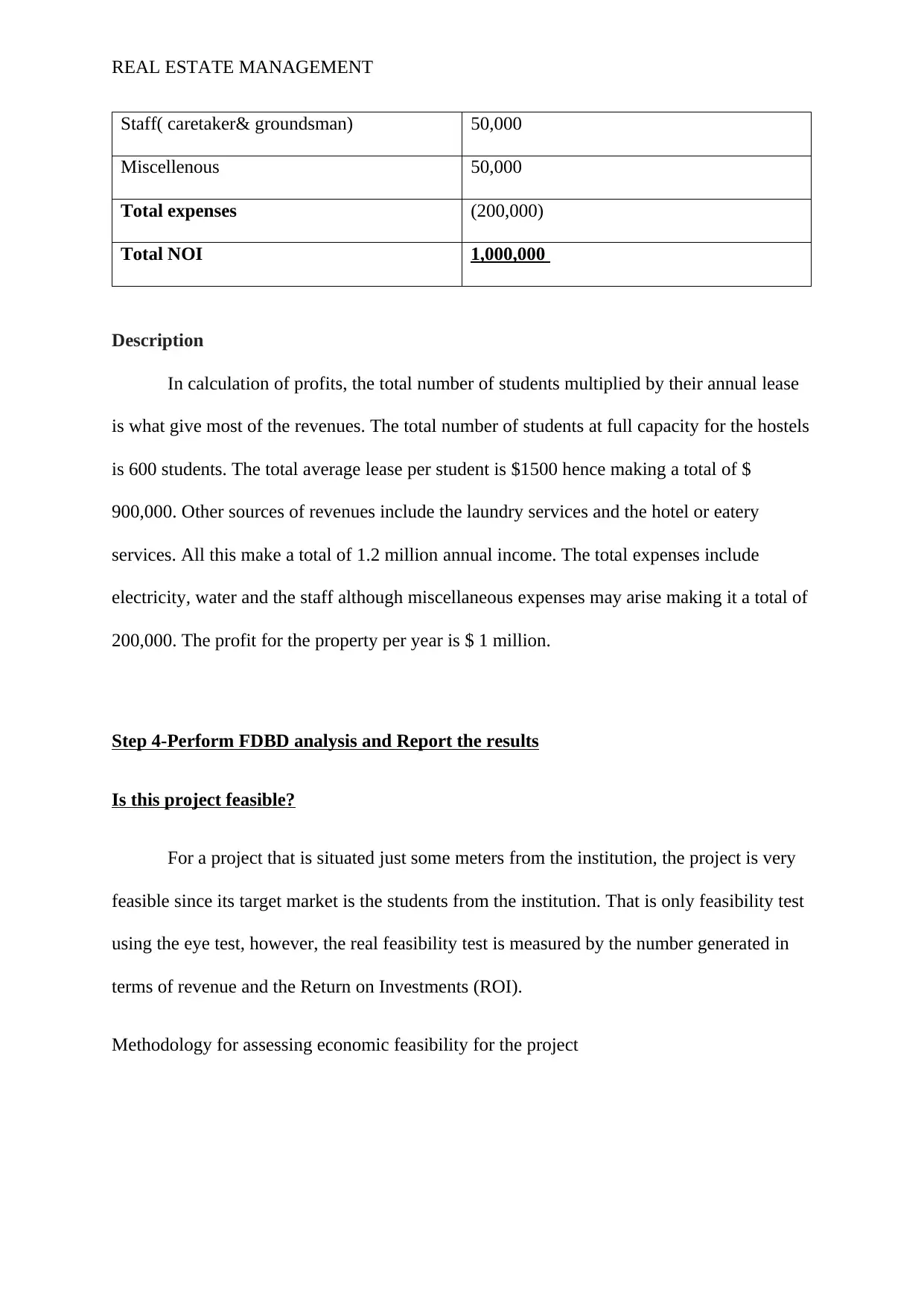
REAL ESTATE MANAGEMENT
Staff( caretaker& groundsman) 50,000
Miscellenous 50,000
Total expenses (200,000)
Total NOI 1,000,000
Description
In calculation of profits, the total number of students multiplied by their annual lease
is what give most of the revenues. The total number of students at full capacity for the hostels
is 600 students. The total average lease per student is $1500 hence making a total of $
900,000. Other sources of revenues include the laundry services and the hotel or eatery
services. All this make a total of 1.2 million annual income. The total expenses include
electricity, water and the staff although miscellaneous expenses may arise making it a total of
200,000. The profit for the property per year is $ 1 million.
Step 4-Perform FDBD analysis and Report the results
Is this project feasible?
For a project that is situated just some meters from the institution, the project is very
feasible since its target market is the students from the institution. That is only feasibility test
using the eye test, however, the real feasibility test is measured by the number generated in
terms of revenue and the Return on Investments (ROI).
Methodology for assessing economic feasibility for the project
Staff( caretaker& groundsman) 50,000
Miscellenous 50,000
Total expenses (200,000)
Total NOI 1,000,000
Description
In calculation of profits, the total number of students multiplied by their annual lease
is what give most of the revenues. The total number of students at full capacity for the hostels
is 600 students. The total average lease per student is $1500 hence making a total of $
900,000. Other sources of revenues include the laundry services and the hotel or eatery
services. All this make a total of 1.2 million annual income. The total expenses include
electricity, water and the staff although miscellaneous expenses may arise making it a total of
200,000. The profit for the property per year is $ 1 million.
Step 4-Perform FDBD analysis and Report the results
Is this project feasible?
For a project that is situated just some meters from the institution, the project is very
feasible since its target market is the students from the institution. That is only feasibility test
using the eye test, however, the real feasibility test is measured by the number generated in
terms of revenue and the Return on Investments (ROI).
Methodology for assessing economic feasibility for the project
⊘ This is a preview!⊘
Do you want full access?
Subscribe today to unlock all pages.

Trusted by 1+ million students worldwide
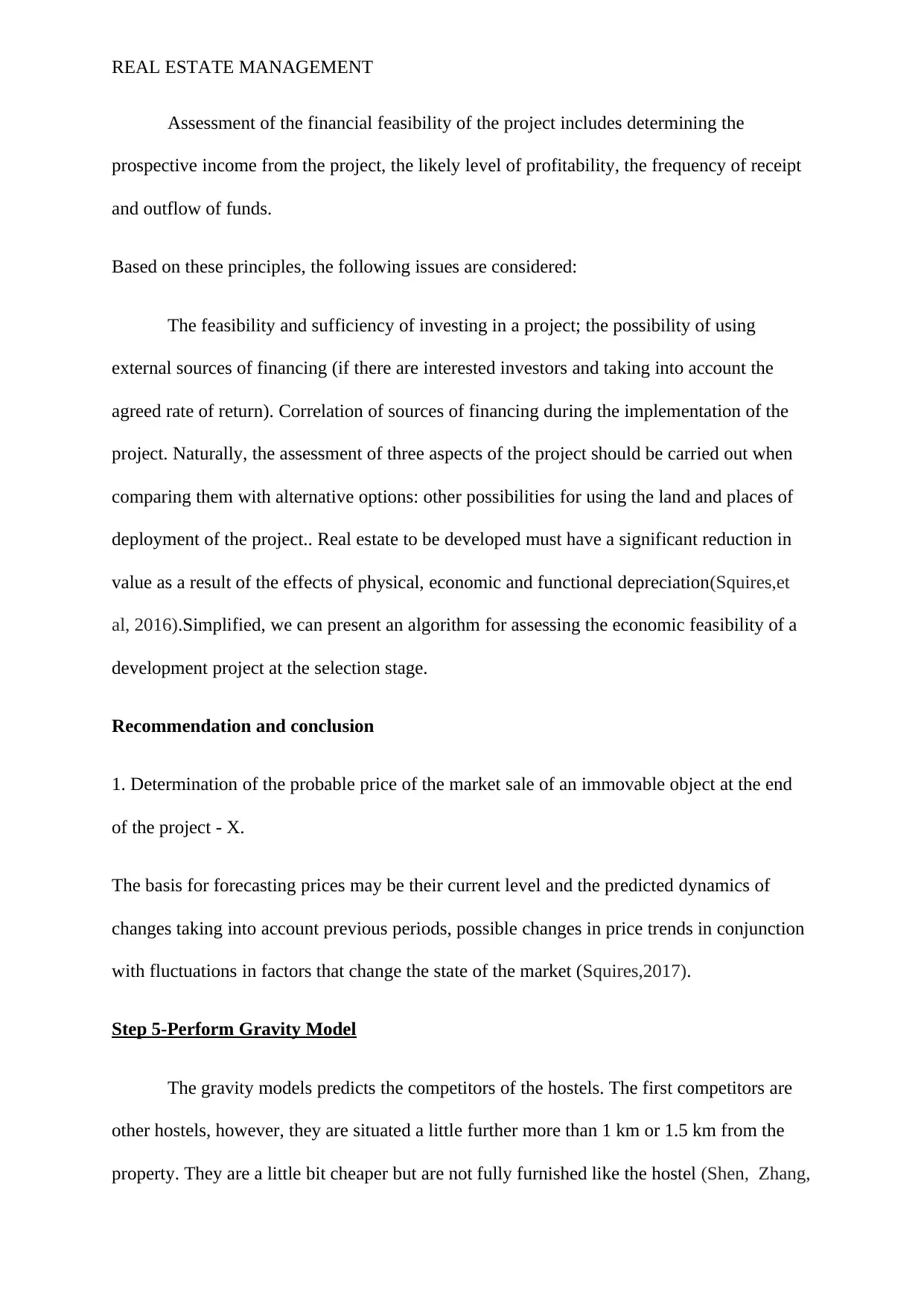
REAL ESTATE MANAGEMENT
Assessment of the financial feasibility of the project includes determining the
prospective income from the project, the likely level of profitability, the frequency of receipt
and outflow of funds.
Based on these principles, the following issues are considered:
The feasibility and sufficiency of investing in a project; the possibility of using
external sources of financing (if there are interested investors and taking into account the
agreed rate of return). Correlation of sources of financing during the implementation of the
project. Naturally, the assessment of three aspects of the project should be carried out when
comparing them with alternative options: other possibilities for using the land and places of
deployment of the project.. Real estate to be developed must have a significant reduction in
value as a result of the effects of physical, economic and functional depreciation(Squires,et
al, 2016).Simplified, we can present an algorithm for assessing the economic feasibility of a
development project at the selection stage.
Recommendation and conclusion
1. Determination of the probable price of the market sale of an immovable object at the end
of the project - X.
The basis for forecasting prices may be their current level and the predicted dynamics of
changes taking into account previous periods, possible changes in price trends in conjunction
with fluctuations in factors that change the state of the market (Squires,2017).
Step 5-Perform Gravity Model
The gravity models predicts the competitors of the hostels. The first competitors are
other hostels, however, they are situated a little further more than 1 km or 1.5 km from the
property. They are a little bit cheaper but are not fully furnished like the hostel (Shen, Zhang,
Assessment of the financial feasibility of the project includes determining the
prospective income from the project, the likely level of profitability, the frequency of receipt
and outflow of funds.
Based on these principles, the following issues are considered:
The feasibility and sufficiency of investing in a project; the possibility of using
external sources of financing (if there are interested investors and taking into account the
agreed rate of return). Correlation of sources of financing during the implementation of the
project. Naturally, the assessment of three aspects of the project should be carried out when
comparing them with alternative options: other possibilities for using the land and places of
deployment of the project.. Real estate to be developed must have a significant reduction in
value as a result of the effects of physical, economic and functional depreciation(Squires,et
al, 2016).Simplified, we can present an algorithm for assessing the economic feasibility of a
development project at the selection stage.
Recommendation and conclusion
1. Determination of the probable price of the market sale of an immovable object at the end
of the project - X.
The basis for forecasting prices may be their current level and the predicted dynamics of
changes taking into account previous periods, possible changes in price trends in conjunction
with fluctuations in factors that change the state of the market (Squires,2017).
Step 5-Perform Gravity Model
The gravity models predicts the competitors of the hostels. The first competitors are
other hostels, however, they are situated a little further more than 1 km or 1.5 km from the
property. They are a little bit cheaper but are not fully furnished like the hostel (Shen, Zhang,
Paraphrase This Document
Need a fresh take? Get an instant paraphrase of this document with our AI Paraphraser
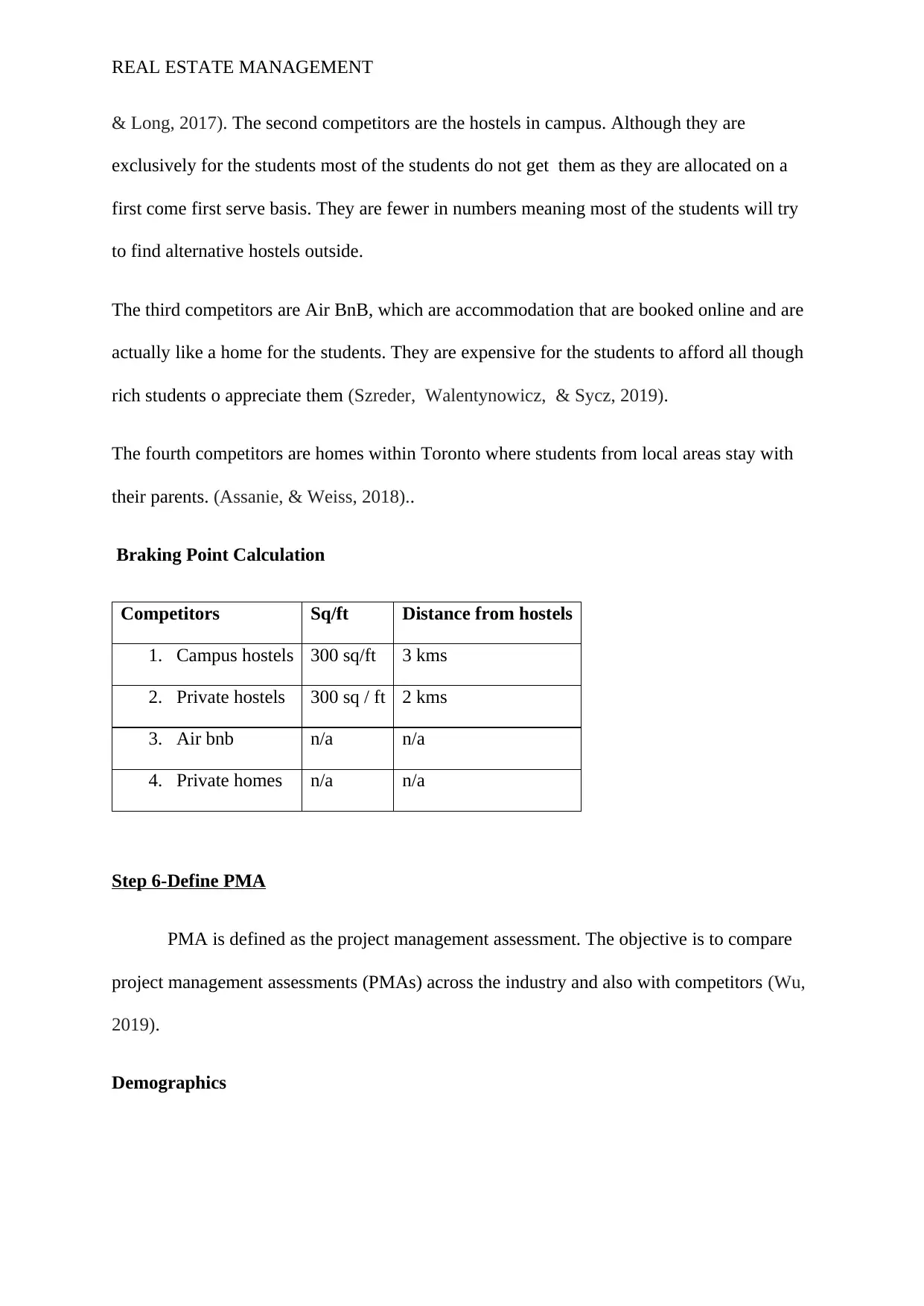
REAL ESTATE MANAGEMENT
& Long, 2017). The second competitors are the hostels in campus. Although they are
exclusively for the students most of the students do not get them as they are allocated on a
first come first serve basis. They are fewer in numbers meaning most of the students will try
to find alternative hostels outside.
The third competitors are Air BnB, which are accommodation that are booked online and are
actually like a home for the students. They are expensive for the students to afford all though
rich students o appreciate them (Szreder, Walentynowicz, & Sycz, 2019).
The fourth competitors are homes within Toronto where students from local areas stay with
their parents. (Assanie, & Weiss, 2018)..
Braking Point Calculation
Competitors Sq/ft Distance from hostels
1. Campus hostels 300 sq/ft 3 kms
2. Private hostels 300 sq / ft 2 kms
3. Air bnb n/a n/a
4. Private homes n/a n/a
Step 6-Define PMA
PMA is defined as the project management assessment. The objective is to compare
project management assessments (PMAs) across the industry and also with competitors (Wu,
2019).
Demographics
& Long, 2017). The second competitors are the hostels in campus. Although they are
exclusively for the students most of the students do not get them as they are allocated on a
first come first serve basis. They are fewer in numbers meaning most of the students will try
to find alternative hostels outside.
The third competitors are Air BnB, which are accommodation that are booked online and are
actually like a home for the students. They are expensive for the students to afford all though
rich students o appreciate them (Szreder, Walentynowicz, & Sycz, 2019).
The fourth competitors are homes within Toronto where students from local areas stay with
their parents. (Assanie, & Weiss, 2018)..
Braking Point Calculation
Competitors Sq/ft Distance from hostels
1. Campus hostels 300 sq/ft 3 kms
2. Private hostels 300 sq / ft 2 kms
3. Air bnb n/a n/a
4. Private homes n/a n/a
Step 6-Define PMA
PMA is defined as the project management assessment. The objective is to compare
project management assessments (PMAs) across the industry and also with competitors (Wu,
2019).
Demographics
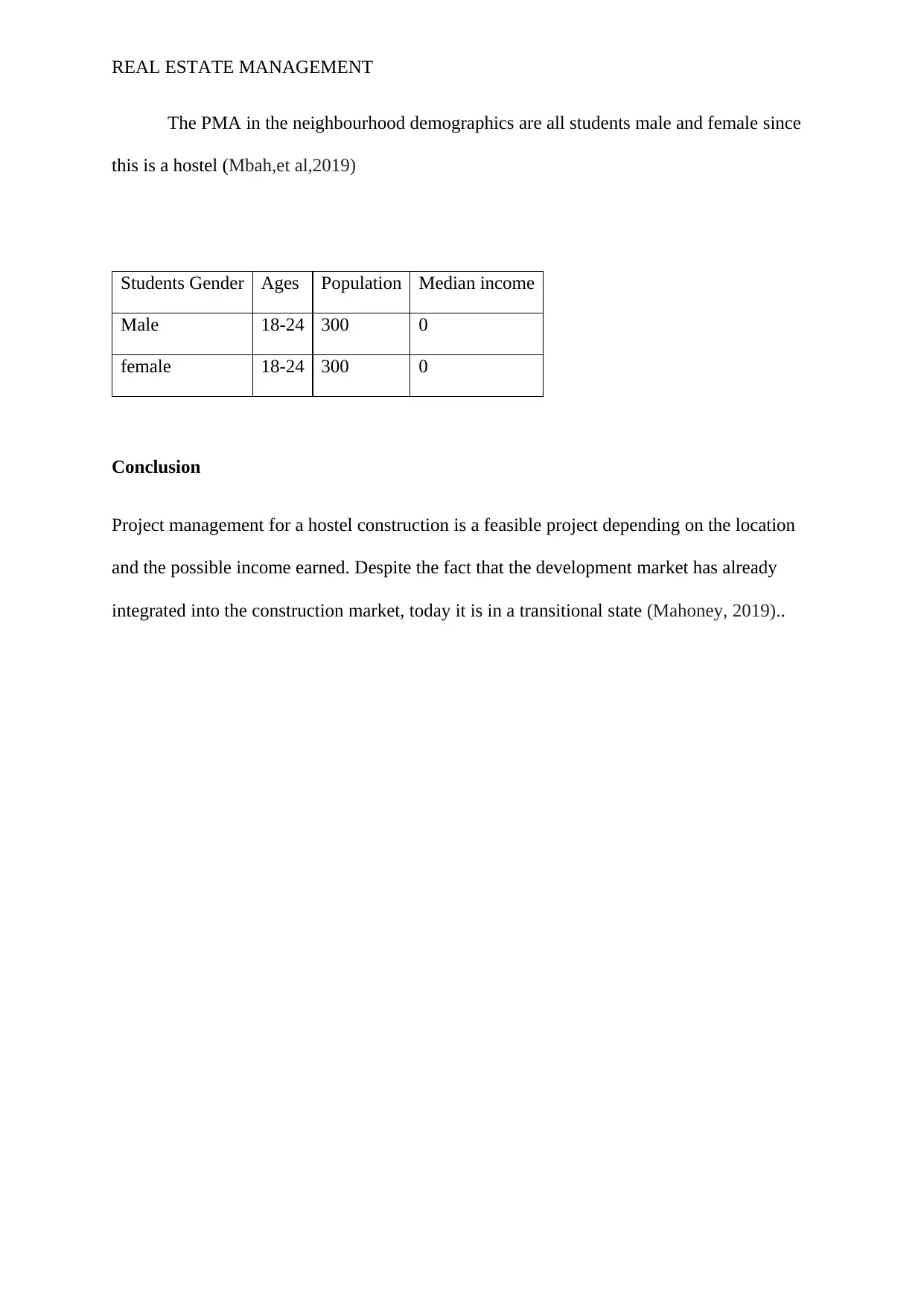
REAL ESTATE MANAGEMENT
The PMA in the neighbourhood demographics are all students male and female since
this is a hostel (Mbah,et al,2019)
Students Gender Ages Population Median income
Male 18-24 300 0
female 18-24 300 0
Conclusion
Project management for a hostel construction is a feasible project depending on the location
and the possible income earned. Despite the fact that the development market has already
integrated into the construction market, today it is in a transitional state (Mahoney, 2019)..
The PMA in the neighbourhood demographics are all students male and female since
this is a hostel (Mbah,et al,2019)
Students Gender Ages Population Median income
Male 18-24 300 0
female 18-24 300 0
Conclusion
Project management for a hostel construction is a feasible project depending on the location
and the possible income earned. Despite the fact that the development market has already
integrated into the construction market, today it is in a transitional state (Mahoney, 2019)..
⊘ This is a preview!⊘
Do you want full access?
Subscribe today to unlock all pages.

Trusted by 1+ million students worldwide
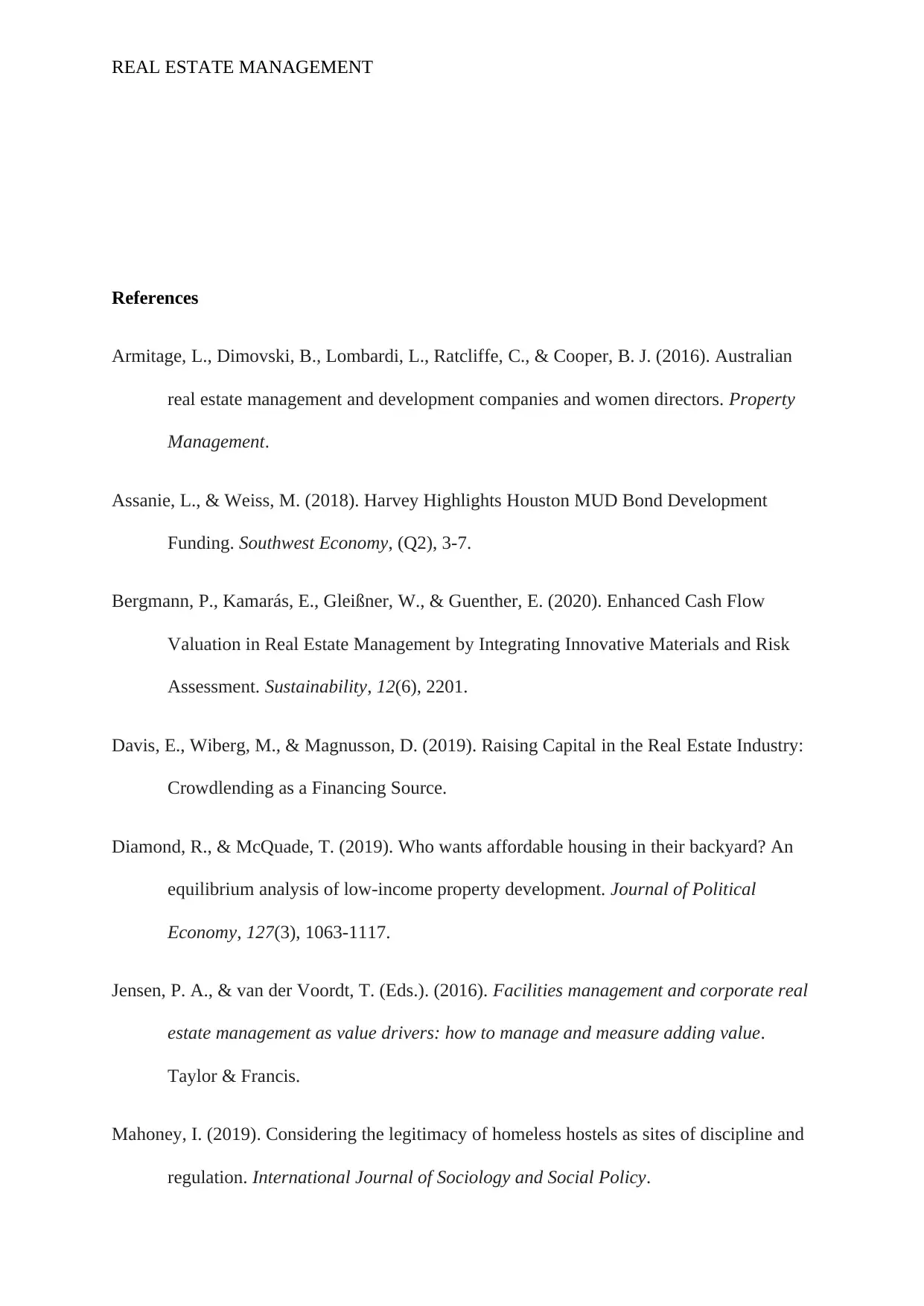
REAL ESTATE MANAGEMENT
References
Armitage, L., Dimovski, B., Lombardi, L., Ratcliffe, C., & Cooper, B. J. (2016). Australian
real estate management and development companies and women directors. Property
Management.
Assanie, L., & Weiss, M. (2018). Harvey Highlights Houston MUD Bond Development
Funding. Southwest Economy, (Q2), 3-7.
Bergmann, P., Kamarás, E., Gleißner, W., & Guenther, E. (2020). Enhanced Cash Flow
Valuation in Real Estate Management by Integrating Innovative Materials and Risk
Assessment. Sustainability, 12(6), 2201.
Davis, E., Wiberg, M., & Magnusson, D. (2019). Raising Capital in the Real Estate Industry:
Crowdlending as a Financing Source.
Diamond, R., & McQuade, T. (2019). Who wants affordable housing in their backyard? An
equilibrium analysis of low-income property development. Journal of Political
Economy, 127(3), 1063-1117.
Jensen, P. A., & van der Voordt, T. (Eds.). (2016). Facilities management and corporate real
estate management as value drivers: how to manage and measure adding value.
Taylor & Francis.
Mahoney, I. (2019). Considering the legitimacy of homeless hostels as sites of discipline and
regulation. International Journal of Sociology and Social Policy.
References
Armitage, L., Dimovski, B., Lombardi, L., Ratcliffe, C., & Cooper, B. J. (2016). Australian
real estate management and development companies and women directors. Property
Management.
Assanie, L., & Weiss, M. (2018). Harvey Highlights Houston MUD Bond Development
Funding. Southwest Economy, (Q2), 3-7.
Bergmann, P., Kamarás, E., Gleißner, W., & Guenther, E. (2020). Enhanced Cash Flow
Valuation in Real Estate Management by Integrating Innovative Materials and Risk
Assessment. Sustainability, 12(6), 2201.
Davis, E., Wiberg, M., & Magnusson, D. (2019). Raising Capital in the Real Estate Industry:
Crowdlending as a Financing Source.
Diamond, R., & McQuade, T. (2019). Who wants affordable housing in their backyard? An
equilibrium analysis of low-income property development. Journal of Political
Economy, 127(3), 1063-1117.
Jensen, P. A., & van der Voordt, T. (Eds.). (2016). Facilities management and corporate real
estate management as value drivers: how to manage and measure adding value.
Taylor & Francis.
Mahoney, I. (2019). Considering the legitimacy of homeless hostels as sites of discipline and
regulation. International Journal of Sociology and Social Policy.
Paraphrase This Document
Need a fresh take? Get an instant paraphrase of this document with our AI Paraphraser
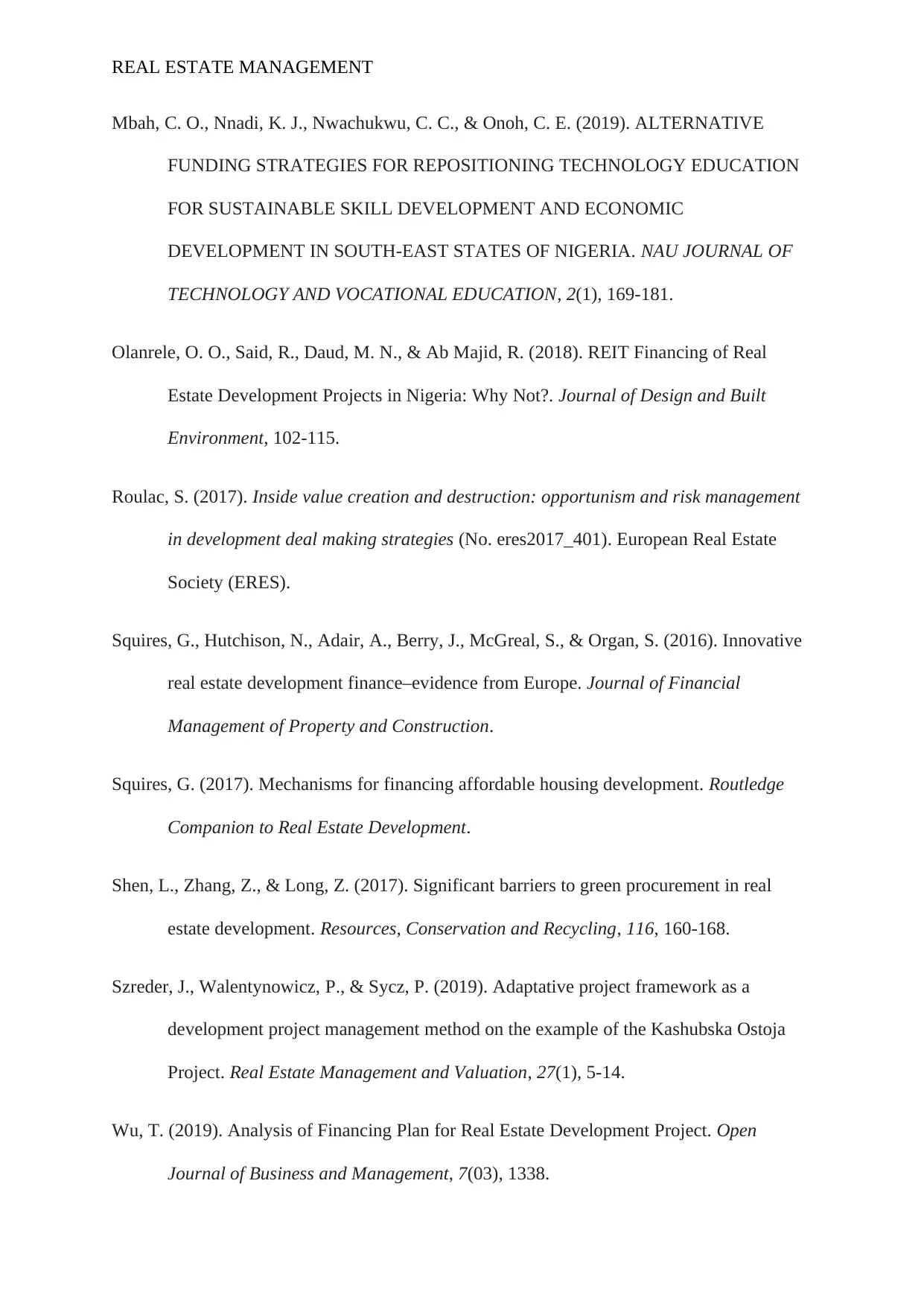
REAL ESTATE MANAGEMENT
Mbah, C. O., Nnadi, K. J., Nwachukwu, C. C., & Onoh, C. E. (2019). ALTERNATIVE
FUNDING STRATEGIES FOR REPOSITIONING TECHNOLOGY EDUCATION
FOR SUSTAINABLE SKILL DEVELOPMENT AND ECONOMIC
DEVELOPMENT IN SOUTH-EAST STATES OF NIGERIA. NAU JOURNAL OF
TECHNOLOGY AND VOCATIONAL EDUCATION, 2(1), 169-181.
Olanrele, O. O., Said, R., Daud, M. N., & Ab Majid, R. (2018). REIT Financing of Real
Estate Development Projects in Nigeria: Why Not?. Journal of Design and Built
Environment, 102-115.
Roulac, S. (2017). Inside value creation and destruction: opportunism and risk management
in development deal making strategies (No. eres2017_401). European Real Estate
Society (ERES).
Squires, G., Hutchison, N., Adair, A., Berry, J., McGreal, S., & Organ, S. (2016). Innovative
real estate development finance–evidence from Europe. Journal of Financial
Management of Property and Construction.
Squires, G. (2017). Mechanisms for financing affordable housing development. Routledge
Companion to Real Estate Development.
Shen, L., Zhang, Z., & Long, Z. (2017). Significant barriers to green procurement in real
estate development. Resources, Conservation and Recycling, 116, 160-168.
Szreder, J., Walentynowicz, P., & Sycz, P. (2019). Adaptative project framework as a
development project management method on the example of the Kashubska Ostoja
Project. Real Estate Management and Valuation, 27(1), 5-14.
Wu, T. (2019). Analysis of Financing Plan for Real Estate Development Project. Open
Journal of Business and Management, 7(03), 1338.
Mbah, C. O., Nnadi, K. J., Nwachukwu, C. C., & Onoh, C. E. (2019). ALTERNATIVE
FUNDING STRATEGIES FOR REPOSITIONING TECHNOLOGY EDUCATION
FOR SUSTAINABLE SKILL DEVELOPMENT AND ECONOMIC
DEVELOPMENT IN SOUTH-EAST STATES OF NIGERIA. NAU JOURNAL OF
TECHNOLOGY AND VOCATIONAL EDUCATION, 2(1), 169-181.
Olanrele, O. O., Said, R., Daud, M. N., & Ab Majid, R. (2018). REIT Financing of Real
Estate Development Projects in Nigeria: Why Not?. Journal of Design and Built
Environment, 102-115.
Roulac, S. (2017). Inside value creation and destruction: opportunism and risk management
in development deal making strategies (No. eres2017_401). European Real Estate
Society (ERES).
Squires, G., Hutchison, N., Adair, A., Berry, J., McGreal, S., & Organ, S. (2016). Innovative
real estate development finance–evidence from Europe. Journal of Financial
Management of Property and Construction.
Squires, G. (2017). Mechanisms for financing affordable housing development. Routledge
Companion to Real Estate Development.
Shen, L., Zhang, Z., & Long, Z. (2017). Significant barriers to green procurement in real
estate development. Resources, Conservation and Recycling, 116, 160-168.
Szreder, J., Walentynowicz, P., & Sycz, P. (2019). Adaptative project framework as a
development project management method on the example of the Kashubska Ostoja
Project. Real Estate Management and Valuation, 27(1), 5-14.
Wu, T. (2019). Analysis of Financing Plan for Real Estate Development Project. Open
Journal of Business and Management, 7(03), 1338.

REAL ESTATE MANAGEMENT
⊘ This is a preview!⊘
Do you want full access?
Subscribe today to unlock all pages.

Trusted by 1+ million students worldwide
1 out of 12
Related Documents
Your All-in-One AI-Powered Toolkit for Academic Success.
+13062052269
info@desklib.com
Available 24*7 on WhatsApp / Email
![[object Object]](/_next/static/media/star-bottom.7253800d.svg)
Unlock your academic potential
© 2024 | Zucol Services PVT LTD | All rights reserved.





